Challenges in Methane Column Retrievals from AVIRIS-NG Imagery over Spectrally Cluttered Surfaces: A Sensitivity Analysis
Abstract
:1. Introduction
1.1. Methane
1.2. Methane Remote Sensing
1.3. Study Motivation
2. Materials and Methods
2.1. Imaging Spectrometers
2.2. Study Area
2.3. Radiative Transfer Simulations—Residual Radiance Method
2.4. Sensitivity Studies
3. Results
3.1. Sensitivity Studies
3.1.1. Sensitivity to Albedo Error
3.1.2. Variation of Albedo Sensitivity with Vertical CH4 Profile
3.1.3. Variation of Albedo Sensitivity with Scene Geometry
3.1.4. Variation of Albedo Sensitivity with Aerosol Type and Visibility
3.1.5. Sensitivity to Spectral Flatness
3.1.6. Sensitivity to Water Vapor
3.2. Space-Based Retrieval Sensitivity to Subpixel Spectral and CH4 Heterogeneity
4. Discussion and Conclusions
4.1. Scoping Study
4.2. In Situ Versus Uniform Profile
4.3. Interferents
4.4. Retrieval Method and Future Work
Acknowledgments
Author Contributions
Conflicts of Interest
Appendix A
Appendix A.1. In Situ Measurements
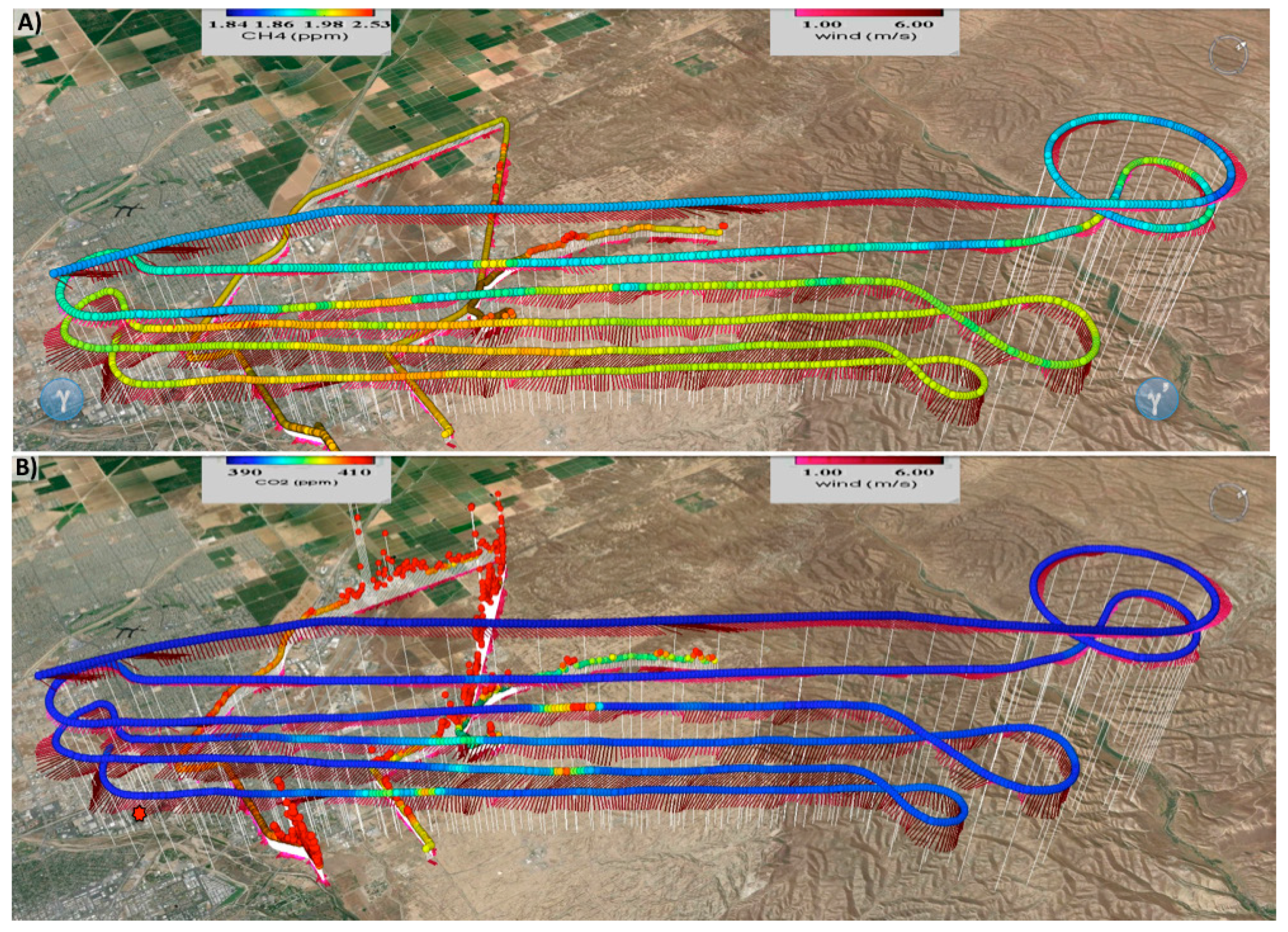
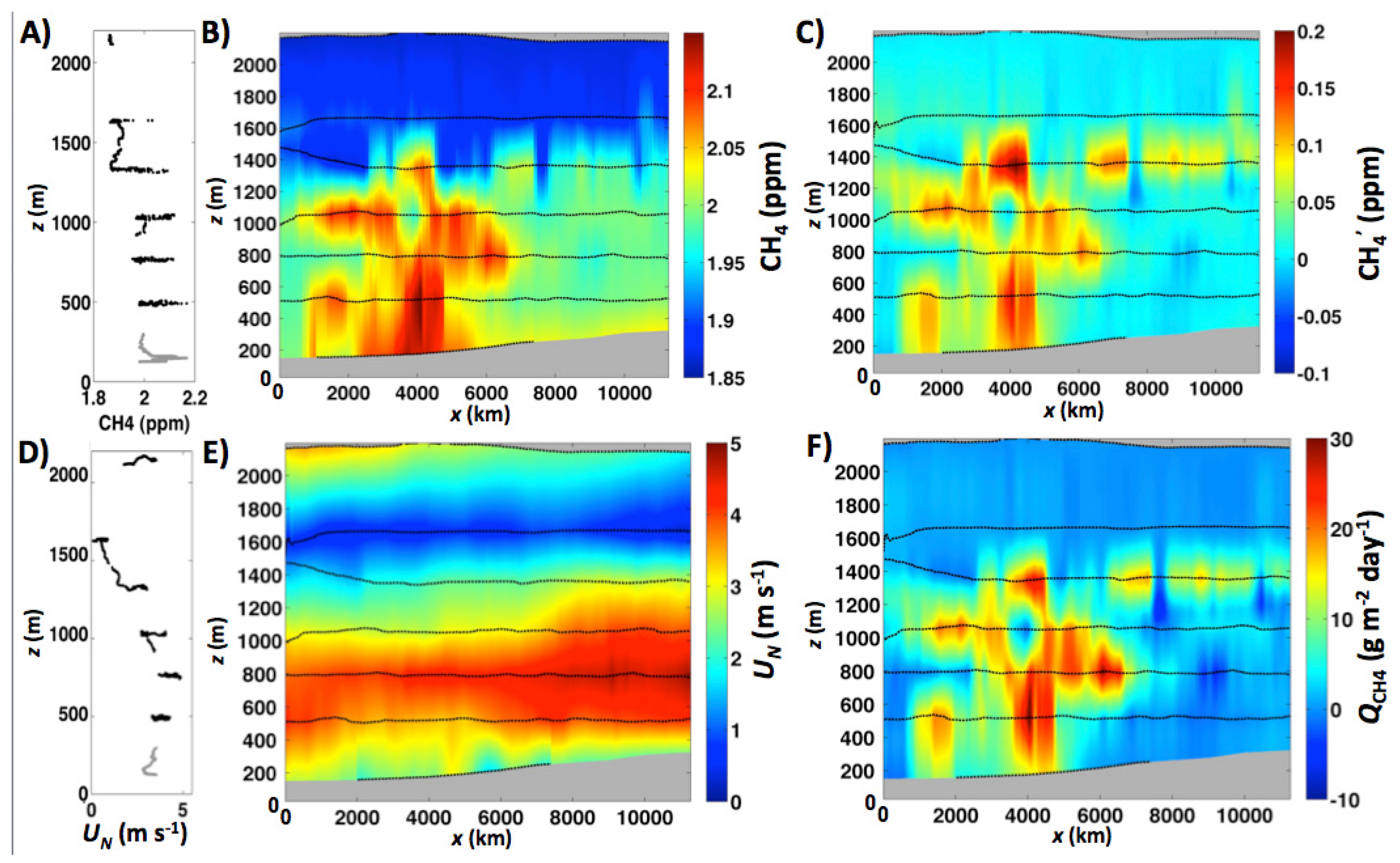
Appendix A.2. Scene Element Selection

Appendix A.3. Requirement for ρs Accuracy in Terms of Accuracy of GOSAT Retrieved XCH4
| XCH4 | Relative Error (%) | ||
|---|---|---|---|
| Ar | Rbl | Bsl | |
| k = 0 | 0.065 | 0.064 | 0.065 |
| k = 0.1 | 0.073 | 0.076 | 0.077 |
| k = 1 | 0.11 | 0.11 | 0.12 |
| k = 10 | 0.27 | 0.27 | 0.26 |
Appendix A.4. Accuracy of Remotely Sensed ρs

Appendix A.5. Expected Accuracy of AVIRIS-NG Retrieved XCH4

References
- IPCC. Climate Change 2013: The Physical Science Basis. Working Group I Contribution to the Fifth Assessment Report of the Intergovernmental Panel on Climate Change; Cambridge University Press: Cambridge, UK, 2014. [Google Scholar]
- Lelieveld, J.O.S.; Crutzen, P.J.; Dentener, F.J. Changing concentration, lifetime and climate forcing of atmospheric methane. Tellus B 1998, 50, 128–150. [Google Scholar] [CrossRef]
- Anderson, B.; Bartlett, K.; Frolking, S.; Hayhoe, K.; Jenkins, J.; Salas, W. Methane and Nitrous Oxide Emissions from Natural Sources; United States Environmental Protection Agency: Washington, DC, USA, 2010.
- Anenberg, S.C.; Schwartz, J.; Shindell, D.; Amann, M.; Faluvegi, G.; Klimont, Z.; Janssens-Maenhout, G.; Pozzoli, L.; Van Dingenen, R.; Vignati, E.; et al. Global air quality and health co-benefits of mitigating near-term climate change through methane and black carbon emission controls. Environ Health Perspect 2012, 120, 831–839. [Google Scholar] [CrossRef] [PubMed] [Green Version]
- Hansen, J.; Sato, M.; Ruedy, R.; Lacis, A.; Oinas, V. Global warming in the twenty-first century: An alternative scenario. Proc. Natl. Acad. Sci. 2000, 97, 9875–9880. [Google Scholar] [CrossRef] [PubMed]
- Nisbet, E.G.; Dlugokencky, E.J.; Bousquet, P. Methane on the rise—again. Science 2014, 343, 493–495. [Google Scholar] [CrossRef] [PubMed] [Green Version]
- Kirschke, S.; Bousquet, P.; Ciais, P.; Saunois, M.; Canadell, J.G.; Dlugokencky, E.J.; Bergamaschi, P.; Bergmann, D.; Blake, D.R.; Bruhwiler, L.; et al. Three decades of global methane sources and sinks. Nat. Geosci. 2013, 6, 813–823. [Google Scholar] [CrossRef]
- Ghosh, A.; Patra, P.K.; Ishijima, K.; Umezawa, T.; Ito, A.; Etheridge, D.M.; Sugawara, S.; Kawamura, K.; Miller, J.B.; Dlugokencky, E.J.; et al. Variations in global methane sources and sinks during 1910–2010. Atmos. Chem. Phys. 2015, 15, 2595–2612. [Google Scholar] [CrossRef]
- Kim, H.-S.; Chung, Y.; Tans, P.; Dlugokencky, E. Decadal trends of atmospheric methane in east asia from 1991 to 2013. Air Qual Atmos Health 2015, 8, 293–298. [Google Scholar] [CrossRef]
- Brandt, A.R.; Heath, G.A.; Kort, E.A.; O’Sullivan, F.; Pétron, G.; Jordaan, S.M.; Tans, P.; Wilcox, J.; Gopstein, A.M.; Arent, D.; et al. Methane leaks from north american natural gas systems. Science 2014, 343, 733–735. [Google Scholar] [CrossRef] [PubMed]
- Miller, S.M.; Wofsy, S.C.; Michalak, A.M.; Kort, E.A.; Andrews, A.E.; Biraud, S.C.; Dlugokencky, E.J.; Eluszkiewicz, J.; Fischer, M.L.; Janssens-Maenhout, G.; et al. Anthropogenic emissions of methane in the united states. Proc. Natl. Acad. Sci. 2013, 110, 20018–20022. [Google Scholar] [CrossRef] [PubMed]
- Dlugokencky, E.J.; Nisbet, E.G.; Fisher, R.; Lowry, D. Global Atmospheric Methane: Budget, Changes and Dangers. Philos. Trans. Soc. A 2011, 369, 2058–2072. [Google Scholar] [CrossRef] [PubMed]
- Buchwitz, M.; Reuter, M.; Bovensmann, H.; Pillai, D.; Heymann, J.; Schneising, O.; Rozanov, V.; Krings, T.; Burrows, J.P.; Boesch, H.; et al. Carbon monitoring satellite (carbonsat): Assessment of atmospheric CO2 and CH4 retrieval errors by error parameterization. Atmos. Meas. Tech. 2013, 6, 3477–3500. [Google Scholar] [CrossRef]
- Buchwitz, M.; Rozanov, V.V.; Burrows, J.P. A near-infrared optimized doas method for the fast global retrieval of atmospheric CH4, CO, CO2, H2O, and N2O total column amounts from sciamachy envisat-1 nadir radiances. J. Geophys. Res. Atmos. 2000, 105, 15231–15245. [Google Scholar] [CrossRef]
- Butz, A.; Hasekamp, O.P.; Frankenberg, C.; Vidot, J.; Aben, I. CH4 retrievals from space-based solar backscatter measurements: Performance evaluation against simulated aerosol and cirrus loaded scenes. J. Geophys. Res. Atmos. 2010, 115, D24302. [Google Scholar] [CrossRef]
- Kuze, A.; Suto, H.; Nakajima, M.; Hamazaki, T. Thermal and near infrared sensor for carbon observation fourier-transform spectrometer on the greenhouse gases observing satellite for greenhouse gases monitoring. Appl. Optics 2009, 48, 6716–6733. [Google Scholar] [CrossRef] [PubMed]
- Schepers, D.; Guerlet, S.; Butz, A.; Landgraf, J.; Frankenberg, C.; Hasekamp, O.; Blavier, J.F.; Deutscher, N.M.; Griffith, D.W.T.; Hase, F.; et al. Methane retrievals from greenhouse gases observing satellite (gosat) shortwave infrared measurements: Performance comparison of proxy and physics retrieval algorithms. J. Geophys. Res. Atmos. 2012, 117, D10307. [Google Scholar] [CrossRef]
- Veefkind, J.P.; Aben, I.; McMullan, K.; Förster, H.; de Vries, J.; Otter, G.; Claas, J.; Eskes, H.J.; de Haan, J.F.; Kleipool, Q.; et al. Tropomi on the esa sentinel-5 precursor: A gmes mission for global observations of the atmospheric composition for climate, air quality and ozone layer applications. Remote Sens. Environ. 2012, 120, 70–83. [Google Scholar] [CrossRef]
- Krings, T.; Gerilowski, K.; Buchwitz, M.; Hartmann, J.; Sachs, T.; Erzinger, J.; Burrows, J.P.; Bovensmann, H. Quantification of methane emission rates from coal mine ventilation shafts using airborne remote sensing data. Atmos. Meas. Tech. 2013, 6, 151–166. [Google Scholar] [CrossRef] [Green Version]
- Tratt, D.M.; Buckland, K.N.; Hall, J.L.; Johnson, P.D.; Keim, E.R.; Leifer, I.; Westberg, K.; Young, S.J. Airborne visualization and quantification of discrete methane sources in the environment. Remote Sens. Environ. 2014, 154, 74–88. [Google Scholar] [CrossRef]
- Kuai, L.; Worden, J.R.; Li, K.; Hulley, G.C.; Hopkins, F.M.; Miller, C.E.; Hook, S.J.; Duren, R.M.; Aubrey, A.D. Characterization of anthropogenic methane plumes with the hyperspectral thermal emission spectrometer (hytes): A retrieval method and error analysis. Atmos. Meas. Tech. Discuss. 2016, 2016, 1–24. [Google Scholar] [CrossRef]
- Thorpe, A.K.; Frankenberg, C.; Roberts, D.A. Retrieval techniques for airborne imaging of methane concentrations using high spatial and moderate spectral resolution: Application to aviris. Atmos. Meas. Tech. 2014, 7, 491–506. [Google Scholar] [CrossRef]
- Thompson, D.R.; Leifer, I.; Bovensmann, H.; Eastwood, M.; Fladeland, M.; Frankenberg, C.; Gerilowski, K.; Green, R.O.; Kratwurst, S.; Krings, T.; et al. Real-time remote detection and measurement for airborne imaging spectroscopy: A case study with methane. Atmos. Meas. Tech. 2015, 8, 4383–4397. [Google Scholar] [CrossRef]
- Bradley, E.S.; Leifer, I.; Roberts, D.A.; Dennison, P.E.; Washburn, L. Detection of marine methane emissions with aviris band ratios. Geophys. Res. Lett. 2011, 38, L10702. [Google Scholar] [CrossRef]
- Thorpe, A.K.; Roberts, D.A.; Bradley, E.S.; Funk, C.C.; Dennison, P.E.; Leifer, I. High resolution mapping of methane emissions from marine and terrestrial sources using a cluster-tuned matched filter technique and imaging spectrometry. Remote Sens. Environ. 2013, 134, 305–318. [Google Scholar] [CrossRef]
- Frankenberg, C.; Meirink, J.F.; van Weele, M.; Platt, U.; Wagner, T. Assessing methane emissions from global space-borne observations. Science 2005, 308, 1010–1014. [Google Scholar] [CrossRef] [PubMed]
- Washburn, L.; Clark, J.F.; Kyriakidis, P. The spatial scales, distribution, and intensity of natural marine hydrocarbon seeps near coal oil point, california. Mar. Petroleum Geology 2005, 22, 569–578. [Google Scholar] [CrossRef]
- Leifer, I.; Melton, C.; Fischer, M.L.; Fladeland, M.; Frash, J.; Gore, W.; Iraci, L.; Marrero, J.; Ryoo, J.M.; Tanaka, T.; et al. Improved atmospheric characterization through fused mobile airborne & surface in situ surveys: Methane emissions quantification from a producing oil field. Atmos. Meas. Tech. Discuss. 2017, 2017, 1–30. [Google Scholar]
- Roberts, D.A.; Bradley, E.S.; Cheung, R.; Leifer, I.; Dennison, P.E.; Margolis, J.S. Mapping methane emissions from a marine geological seep source using imaging spectrometry. Remote Sens. Environ. 2010, 114, 592–606. [Google Scholar] [CrossRef]
- Green, R.O.; Eastwood, M.L.; Sarture, C.M.; Chrien, T.G.; Aronsson, M.; Chippendale, B.J.; Faust, J.A.; Pavri, B.E.; Chovit, C.J.; Solis, M.; et al. Imaging spectroscopy and the airborne visible/infrared imaging spectrometer (aviris). Remote Sens. Environ. 1998, 65, 227–248. [Google Scholar] [CrossRef]
- Hamlin, L.; Green, R.O.; Mouroulis, P.; Eastwood, M.; Wilson, D.; Dudik, M.; Paine, C. Imaging spectrometer science measurements for terrestrial ecology: AVIRIS and new developments. In NASA Earth Science Technology Forum; Jet Propul. Lab: Paseda, CA, USA, 2010. [Google Scholar]
- Dennison, P.E.; Thorpe, A.K.; Pardyjak, E.R.; Roberts, D.A.; Qi, Y.; Green, R.O.; Bradley, E.S.; Funk, C.C. High spatial resolution mapping of elevated atmospheric carbon dioxide using airborne imaging spectroscopy: Radiative transfer modeling and power plant plume detection. Remote Sens. Environ. 2013, 139, 116–129. [Google Scholar] [CrossRef]
- Green, R.O.; Pavri, B. Aviris Inflight Calibration Experiment Measurements, Analyses, and Results in 2000. In Proceedings of the Tenth JPL Airvorne Earth Science Workshop, Pasadena, CA, USA, 5–8 March 2002. [Google Scholar]
- Krautwurst, S.; Gerilowski, K.; Krings, T.; Borchard, J.; Bovensmann, H. COMEX—Final Report. Available online: https://espo.nasa.gov/missions/sites/default/files/documents/COMEX_FR_v2.0_final_.pdf (accessed on 12 August 2017).
- Kaufman, Y.J.; Bo-Cai, G. Remote sensing of water vapor in the near ir from eos/modis. IEEE Trans. Geosci. Remote Sens. 1992, 30, 871–884. [Google Scholar] [CrossRef]
- Albert, P.; Bennartz, R.; Preusker, R.; Leinweber, R.; Fischer, J. Remote sensing of atmospheric water vapor using the moderate resolution imaging spectroradiometer. J. Atmos. Ocean. Technol. 2005, 22, 309–314. [Google Scholar] [CrossRef]
- HyspIRI. Hyspiri Mission Study Website. Available online: http://hyspiri.jpl.nasa.gov/ (accessed on 6 March 2011).
- Noël, S.; Bramstedt, K.; Bovensmann, H.; Gerilowski, K.; Burrows, J.P.; Standfuss, C.; Dufour, E.; Veihelmann, B. Quantification and mitigation of the impact of scene inhomogeneity on sentinel-4 uvn uv-vis retrievals. Atmos. Meas. Tech. 2012, 5, 1319–1331. [Google Scholar] [CrossRef]
- Cirpas, the Center for Interdisciplinary Remotely-Piloted Aircraft Studies. Available online: www.cirpas.org (accessed on 1 November 2014).
- Sweet, J.N. The Spectral Similarity Scale and Its Application to the Classification of Hyperspectral Remote Sensing Data. In Proceedings of the 2003 IEEE Workshop on Advances in Techniques for Analysis of Remotely Sensed Data, Greenbelt, MD, USA, 27–28 Octomber 2003. [Google Scholar]
- Morino, I.; Uchino, O.; Inoue, M.; Yoshida, Y.; Yokota, T.; Wennberg, P.O.; Toon, G.C.; Wunch, D.; Roehl, C.M.; Notholt, J.; et al. Preliminary validation of column-averaged volume mixing ratios of carbon dioxide and methane retrieved from GOSAT short-wavelength infrared spectra. Atmos. Meas. Tech. 2011, 4, 1061–1076. [Google Scholar] [CrossRef]
- Butz, A.; Guerlet, S.; Hasekamp, O.; Schepers, D.; Galli, A.; Aben, I.; Frankenberg, C.; Hartmann, J.M.; Tran, H.; Kuze, A.; et al. Toward accurate CO2 and CH4 observations from gosat. Geophys. Res. Lett. 2011, 38, L14812. [Google Scholar] [CrossRef]
- Privette, J.L.; Mukelabai, M.; Zhang, H.; Schaaf, C.B. Characterization of MODIS land albedo (mod43) accuracy with atmospheric conditions in Africa. In Proceedings of the 2004 IEEE International Geoscience and Remote Sensing Symposium, Anchorage, AK, USA, 20–24 September 2004. [Google Scholar]
- Wang, K.; Liu, J.; Zhou, X.; Sparrow, M.; Ma, M.; Sun, Z.; Jiang, W. Validation of the modis global land surface albedo product using ground measurements in a semidesert region on the tibetan plateau. J. Geophys. Res. Atmos. 2004, 109, D05107. [Google Scholar] [CrossRef]
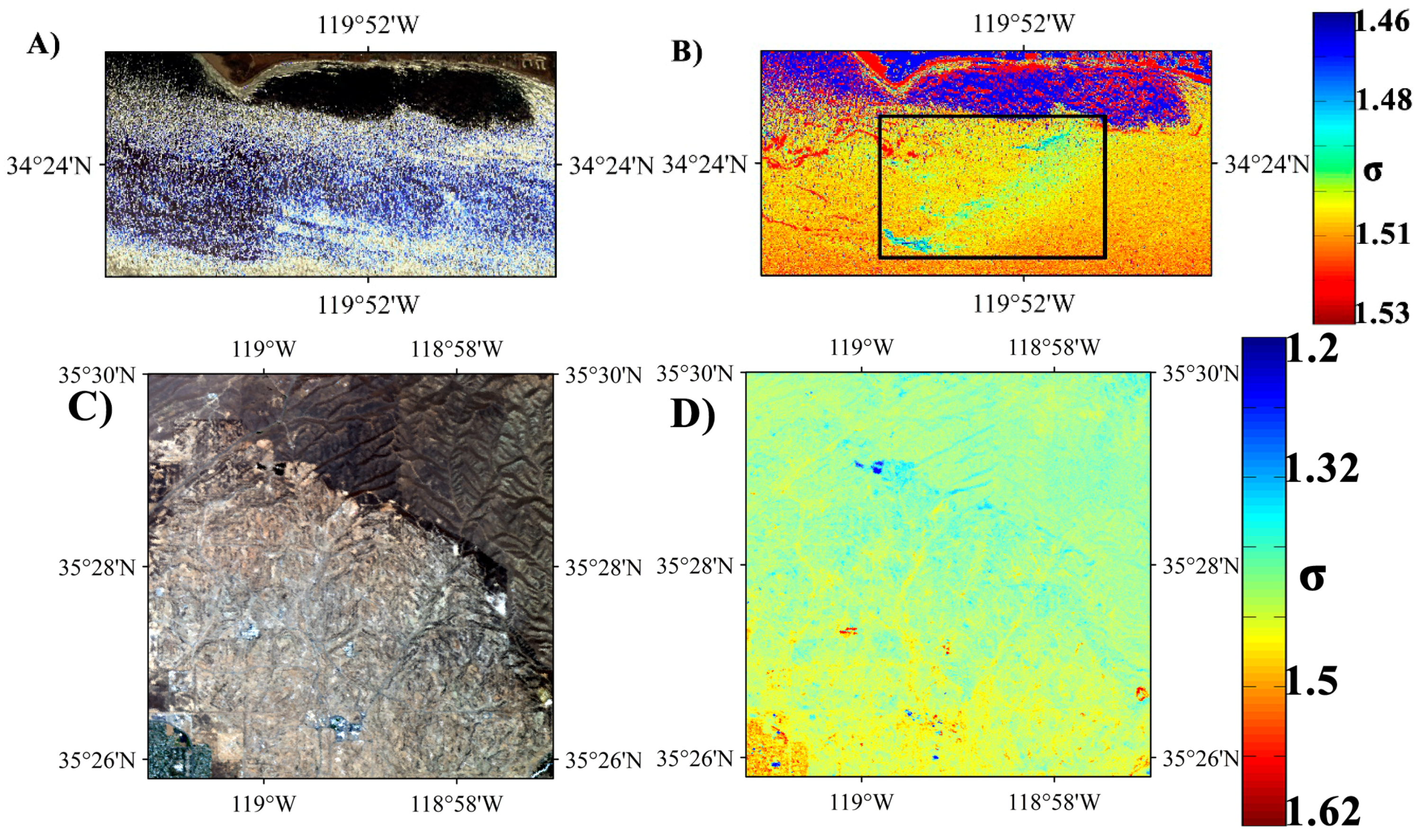
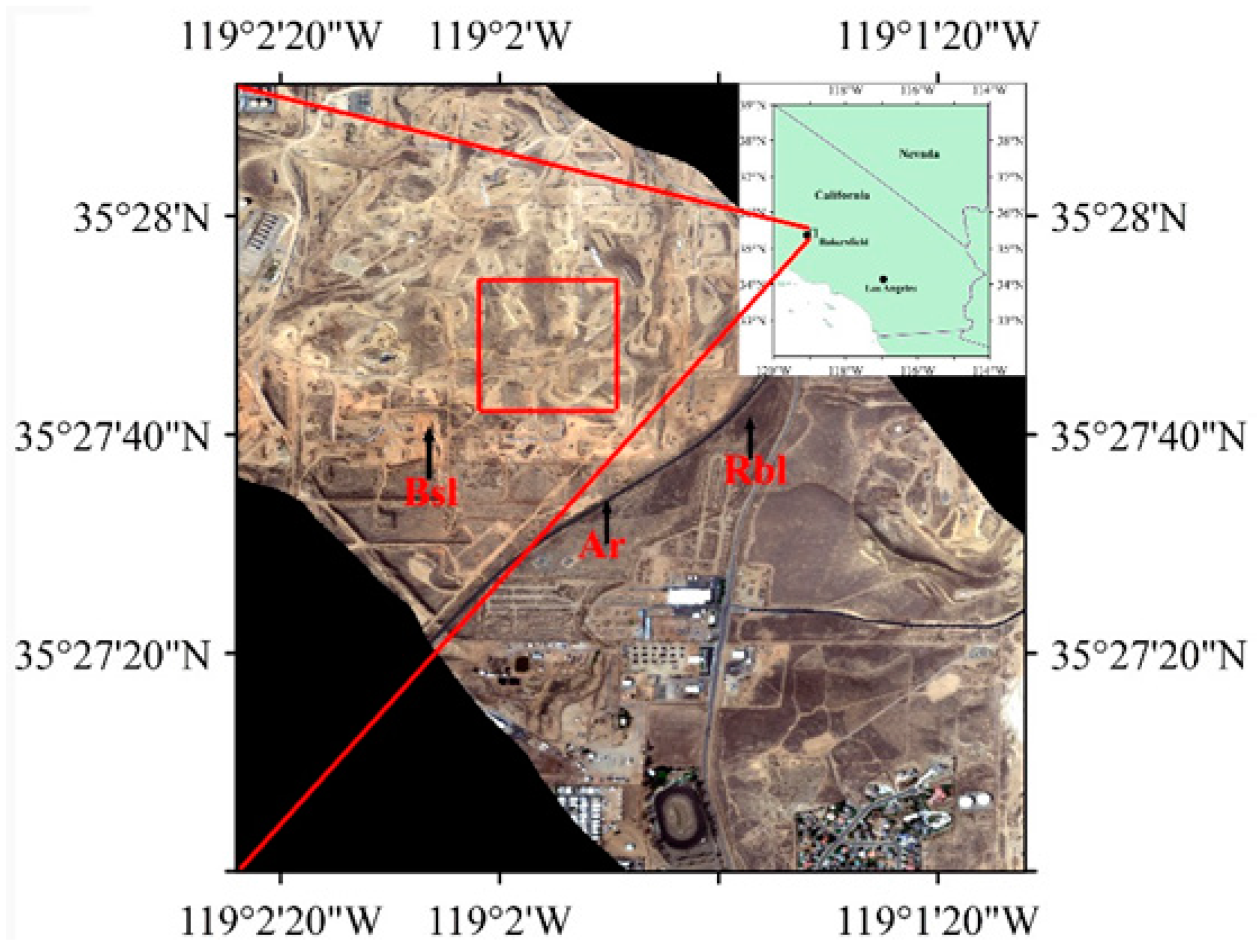

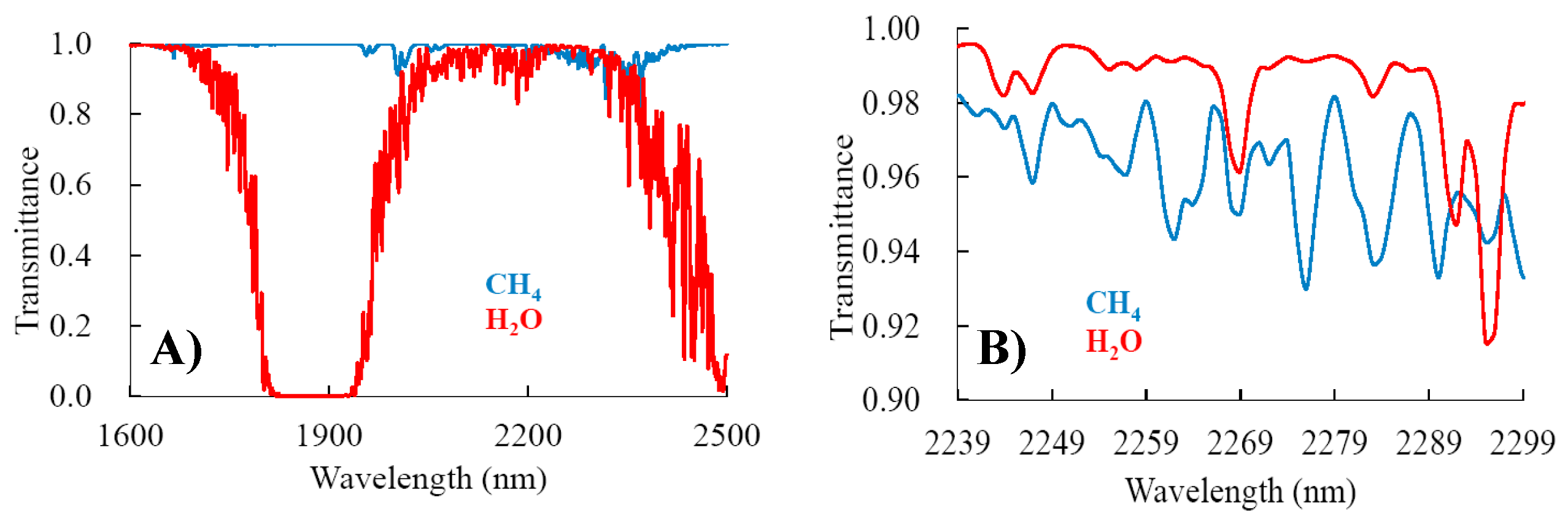

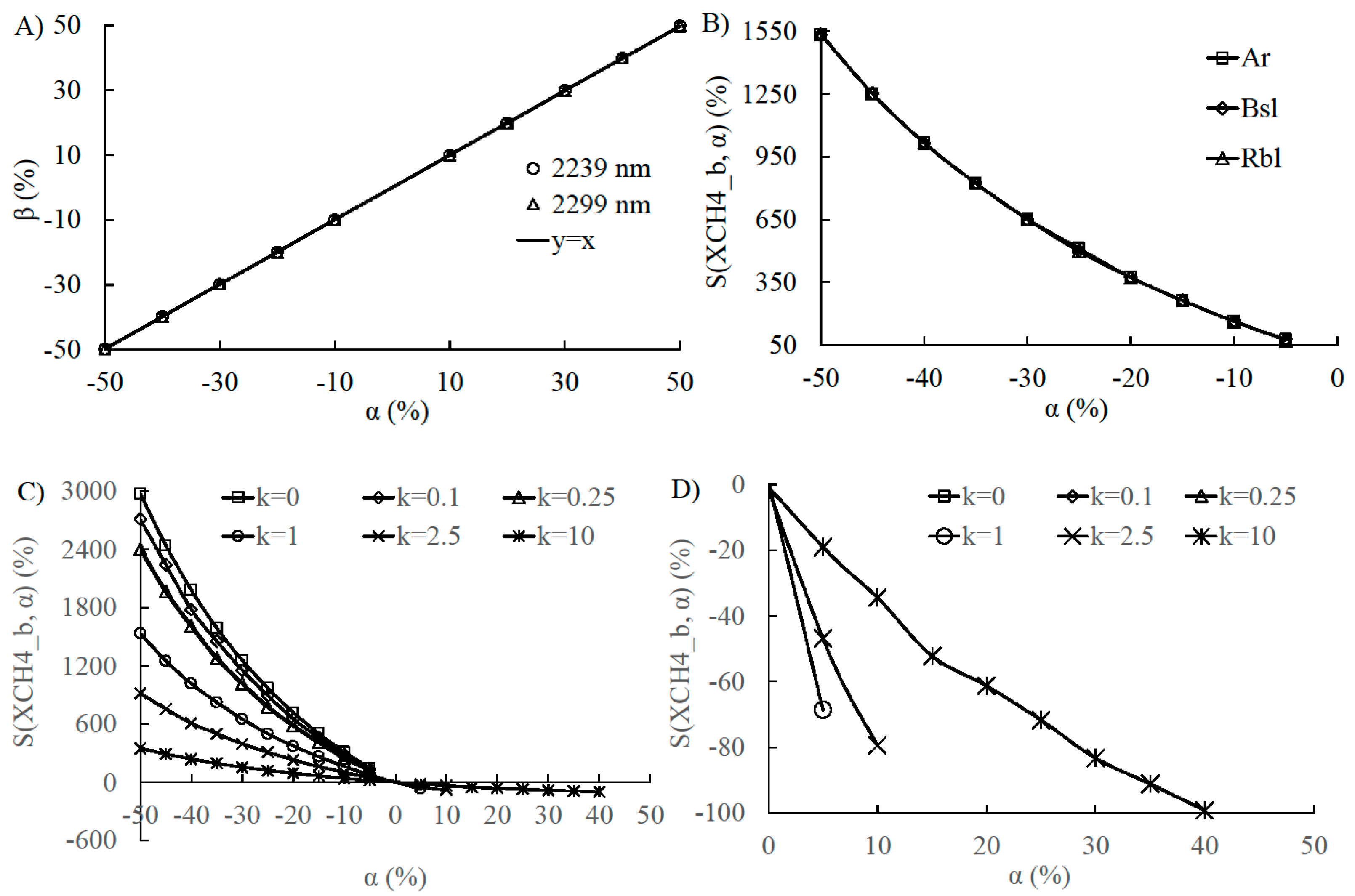
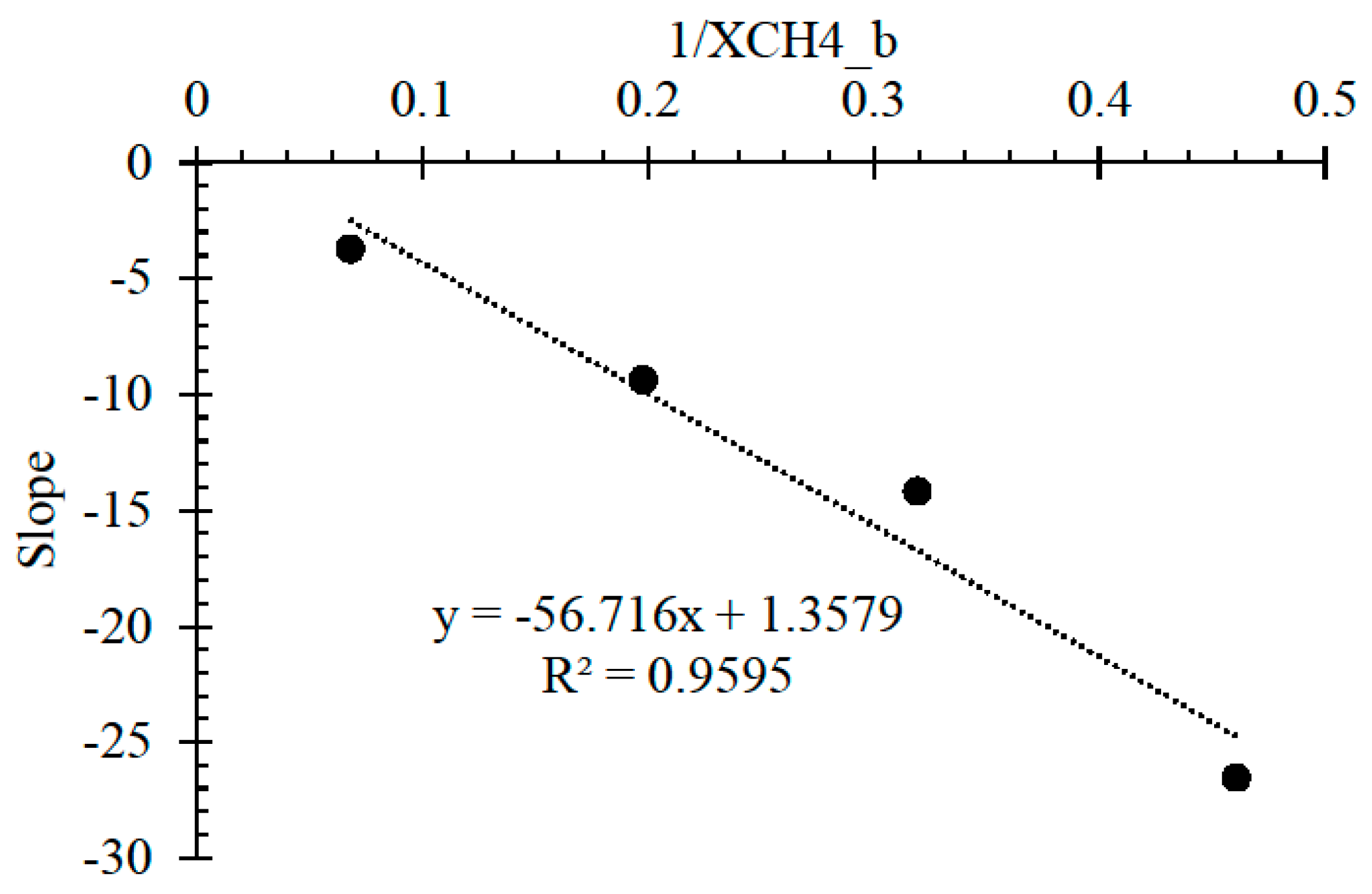
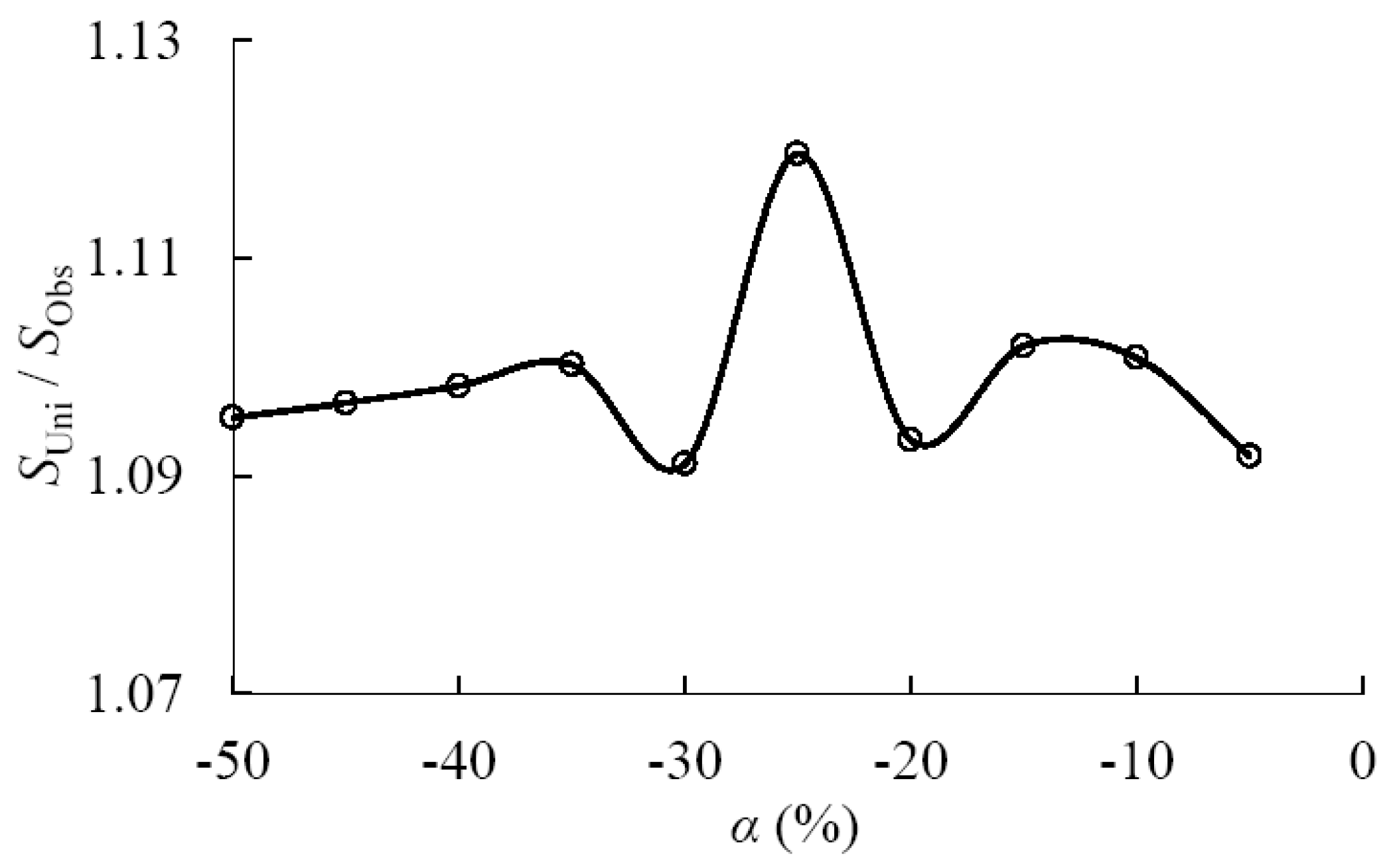
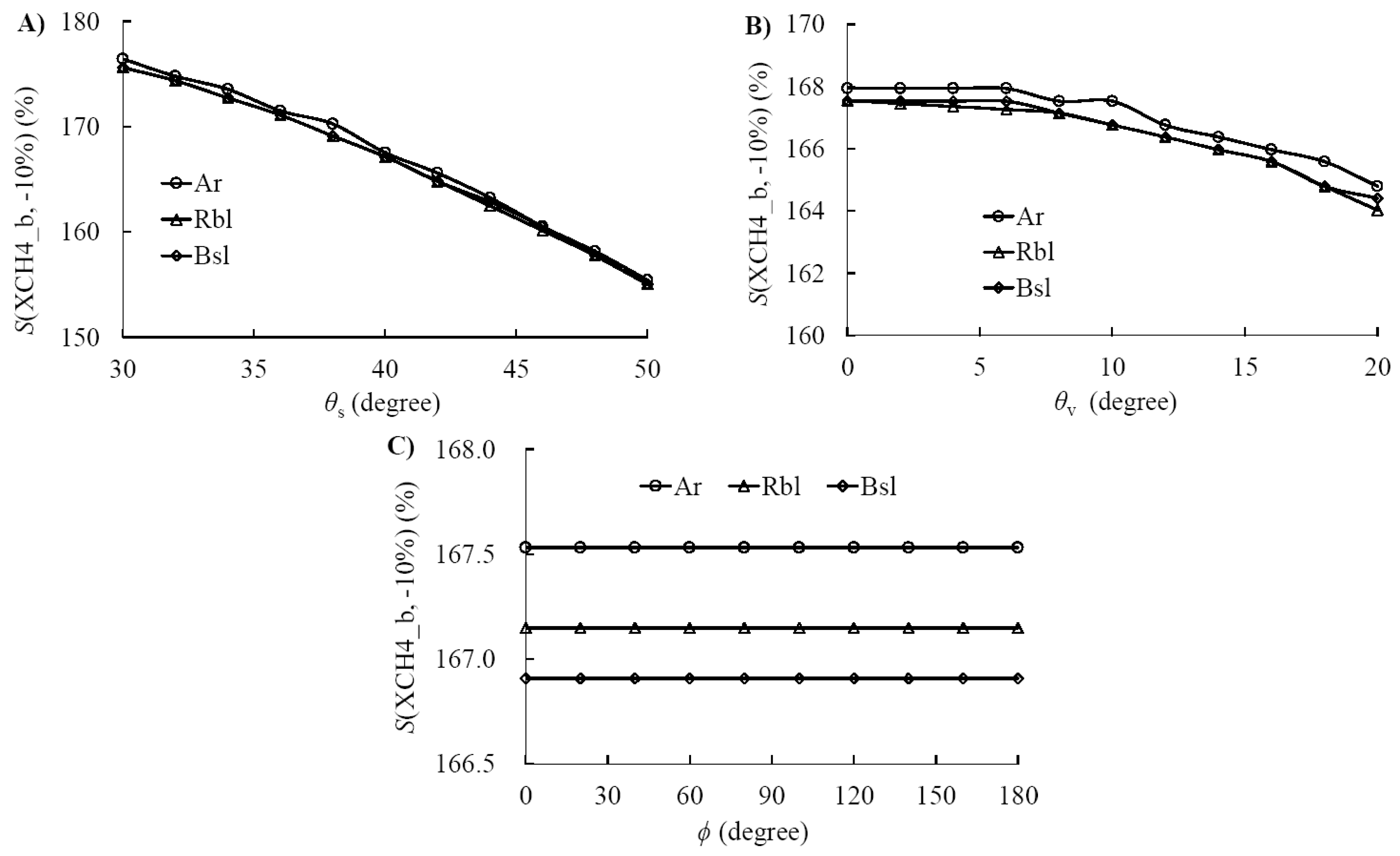

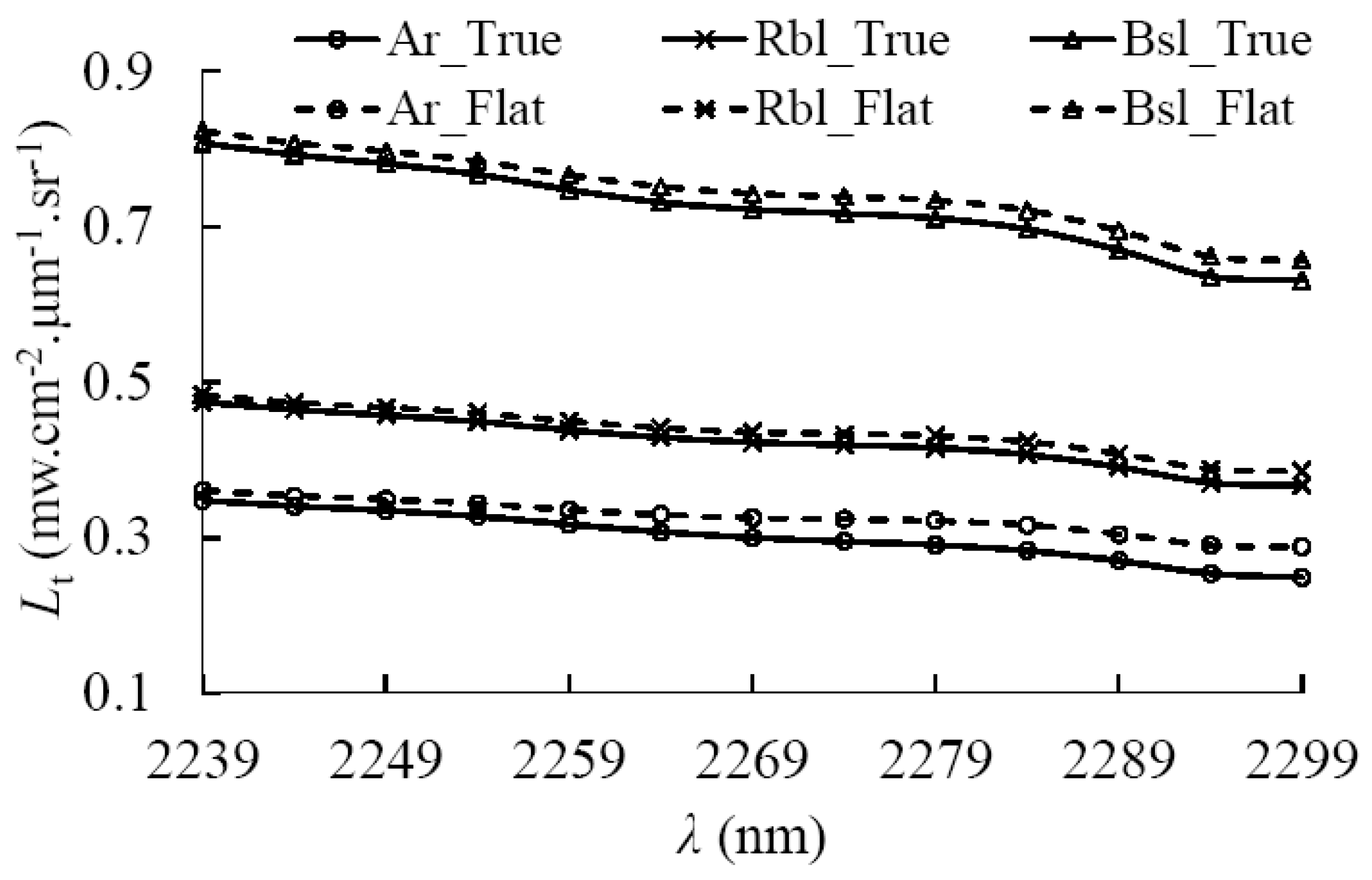


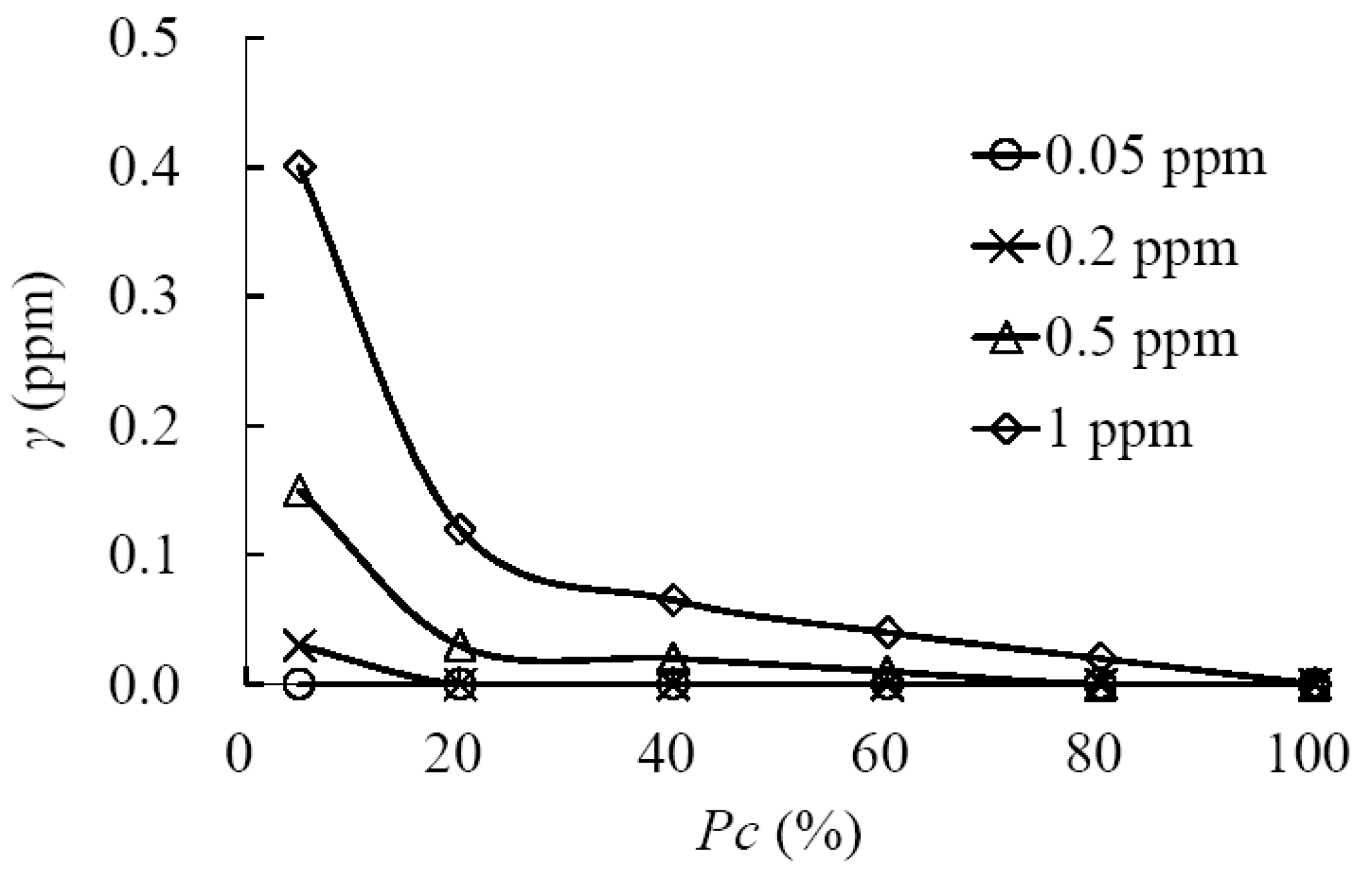
| Symbol | Definition | Unit |
|---|---|---|
| Ar | Asphalt road | N/A |
| Bsl | Brown sandy loam | N/A |
| Rbl | Reddish-brown fine sandy loam | N/A |
| GOSAT | Greenhouse gases Observing SATellite | N/A |
| i | Band number | N/A |
| k | Scaling factor forXCH4_p | N/A |
| Lt(α, λ) | at-sensor radiance in wavelength λ for a ρs relative error of α | mW cm−2 μm−1 sr−1 |
| S(XCH4_b, α) | Albedo sensitivity with a scenario, XCH4_b and the relative error, α, in ρs | dimensionless |
| XCH4 | Methane column ratio | ppm |
| XCH4_A | Background methane column ratio | ppm |
| XCH4_P | Plume methane column ratio | ppm |
| XCH4_b | Base XCH4 | ppm |
| XCH4_err | XCH4 from trial and error | ppm |
| XCH4_GOSAT | Mean XCH4 over subpixels in GOSAT pixel | ppm |
| θs | Solar zenith angle | degree |
| θv | Viewing zenith angle | degree |
| ϕ | Relative sun-sensor azimuth angle | degree |
| λ | Wavelength | nm |
| ρs(λ) | Surface albedo | dimensionless |
| ρt(λ) | At-sensor reflectance | dimensionless |
| Lt(λ) | At-sensor radiance | mW cm−2 μm−1 sr−1 |
| Lt_GOSAT(λ) | Mean Lt(λ) over subpixels in GOSAT pixel | mW cm−2 μm−1 sr−1 |
| Lt_AO(λ) | Mean Lt over the subpixels | mW cm−2 μm−1 sr−1 |
| Lt_OA(λ) | Lt for the mean surface albedo over subpixels | mW cm−2 μm−1 sr−1 |
| Lt_err | Lt for the original albedo and XCH4 with 10% underestimation | mW cm−2 μm−1 sr−1 |
| ρs_err | ρs corresponding to Lt_err and the original XCH4 | dimensionless |
| XCH4_M | XCH4 corresponding to Lt_GOSAT and mean albedo over GOSAT subpixels | ppm |
| NEδL | Noise equivalent delta radiance | mW cm−2 μm−1 sr−1 |
| NEδLa | NEδL adjusted to the band average | mW cm−2 μm−1 sr−1 |
| α | Relative error in surface albedo | % |
| β | Relative error in Lt | % |
| γ | Underestimate of XCH4 resulted from the subpixel heterogeneity of CH4 | ppm |
| σ | ρt(2298)/ρt(2058) | dimensionless |
| Δ | Average residual radiance | mW cm−2 μm−1 sr−1 |
| Pc | Percentage of area in one GOSAT pixel covered by XCH4 plume | % |
| XCH4_b | Underestimation (%) | ||
|---|---|---|---|
| Ar | Rbl | Bsl | |
| k = 0 | - | −79.77 | −73.72 |
| k = 0.1 | −120.73 | −70.35 | −63.97 |
| k = 1 | −79.68 | −35.81 | −30.95 |
| k = 10 | −30.18 | −10.65 | −8.08 |
© 2017 by the authors. Licensee MDPI, Basel, Switzerland. This article is an open access article distributed under the terms and conditions of the Creative Commons Attribution (CC BY) license (http://creativecommons.org/licenses/by/4.0/).
Share and Cite
Zhang, M.; Leifer, I.; Hu, C. Challenges in Methane Column Retrievals from AVIRIS-NG Imagery over Spectrally Cluttered Surfaces: A Sensitivity Analysis. Remote Sens. 2017, 9, 835. https://doi.org/10.3390/rs9080835
Zhang M, Leifer I, Hu C. Challenges in Methane Column Retrievals from AVIRIS-NG Imagery over Spectrally Cluttered Surfaces: A Sensitivity Analysis. Remote Sensing. 2017; 9(8):835. https://doi.org/10.3390/rs9080835
Chicago/Turabian StyleZhang, Minwei, Ira Leifer, and Chuanmin Hu. 2017. "Challenges in Methane Column Retrievals from AVIRIS-NG Imagery over Spectrally Cluttered Surfaces: A Sensitivity Analysis" Remote Sensing 9, no. 8: 835. https://doi.org/10.3390/rs9080835





